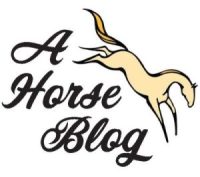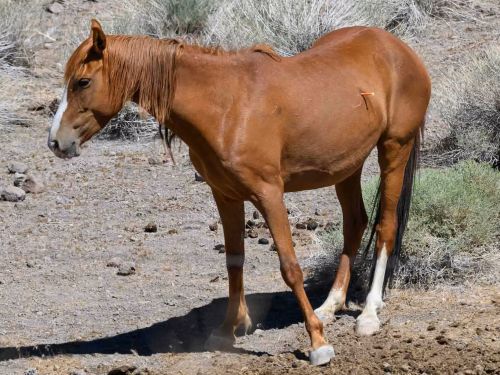Last Updated on August 10, 2025 by adminahb
Image: A wild horse with a misplaced dart in its abdominal wall. Courtesy of Michele Cheeseman
Introduction
Wild horses, roaming the arid rangelands of the American West, embody a legacy of freedom and resilience. Managed by the Bureau of Land Management (BLM) across Herd Management Areas (HMAs), these populations face a dual challenge: immediate welfare risks from poorly executed contraceptive darting and long-term genetic vulnerabilities exacerbated by chemical sterilization methods like Porcine Zona Pellucida (PZP) and GonaCon. A compelling photograph of a wild horse with a dart lodged in its abdominal wall underscores the dangers of inadequate training and poor marksmanship, while scientific evidence highlights how these practices, combined with small herd sizes and historical bottlenecks, accelerate genetic loss. Given the dire situation wild horses are already in — with populations bottlenecked, heterozygosity declining rapidly, and many HMAs below viable sizes — any form of contraception only worsens the crisis by imposing artificial selection and further eroding genetic diversity. This article explores these intertwined issues, rejecting contraception entirely and advocating for rewilding as the humane, science-based path forward.
The Image: A Stark Warning
The photograph above depicts a sorrel wild horse — marked by its reddish-brown coat, white facial blaze, and white socks — standing in a dry, rocky landscape dotted with sagebrush. The horse appears calm, mid-step with its head lowered, but a small, brightly colored dart protrudes from its left flank in the upper abdominal wall, known as the paralumbar fossa. This area, posterior to the ribs and anterior to the hip, is far from the recommended hindquarter target site for darting.
The image, courtesy of Michele Cheeseman, serves as a visual testament to the consequences of poorly trained darters or inaccurate shots. Such misplacements highlight a critical gap in field practices, where lack of skill or experience transforms a supposedly humane tool into a potential hazard, further illustrating why contraception via darting should be abandoned.
Dangers of Poorly Trained Darters and Misplaced Darts
Proper darting requires precision, targeting the hindquarters — specifically the gluteal muscles or biceps femoris — for safe intramuscular injection of PZP or GonaCon. Guidelines from the BLM and wildlife veterinarians mandate training, often through certified courses, and teamwork (e.g., one darter, one observer) to ensure accuracy at ranges under 50 meters. However, when poorly trained individuals or poor marksmen handle dart rifles, the results can be disastrous:
1. Immediate Physical Harm
Misplaced darts, like the one in the photo, strike thinner areas such as the abdominal wall. The dart’s impact — delivered by compressed gas or powder charges — can cause bruising, lacerations, or penetration into the peritoneal cavity.
Risks include internal bleeding, organ damage (e.g., intestines, kidneys), or peritonitis, leading to colic — severe pain and gastrointestinal issues that can be fatal in horses without veterinary care. The horse in the image shows no immediate distress, but hidden injuries could develop if untreated.
2. Vaccine Delivery Failures
In non-muscular sites, darts may fail to fully discharge, resulting in under-dosing or leakage. Internal spillage of PZP or GonaCon can cause chemical irritation, reducing efficacy and potentially triggering sterile inflammation. This wastes resources and skews population control efforts.
3. Infection and Chronic Issues
Open wounds in dusty environments heighten infection risks, leading to abscesses or sepsis. Studies report injection-site reactions (e.g., swellings lasting months) in up to 79% of GonaCon-treated horses, with severity increasing in misplacements. Chronic pain or lameness could impair mobility, affecting foraging or herd dynamics.
4. Welfare and Management Challenges
Poorly trained darters may violate safety protocols (e.g., firing near people or in high winds), endangering both horses and handlers. Recovery of misplaced darts is often neglected, leaving environmental hazards and unconfirmed dosing. In remote HMAs, veterinary intervention is impractical, prolonging suffering and raising ethical concerns.
These physical risks are compounded by the fact that contraception itself is unnecessary and harmful, as it fails to address root causes while inflicting additional stress on already vulnerable populations.
Click here to read the full article.
Visit www.wildhorsefirebrigade.org for more information.

